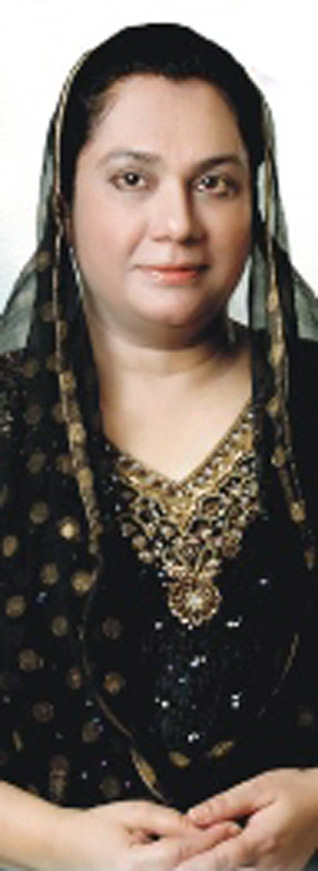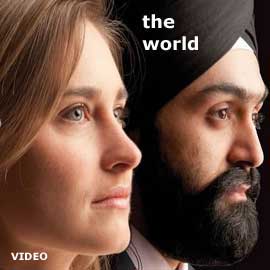Music
Singing in Raag Gauri
GURMUKH SINGH
Gauri raag is auspicious when it induces meditative contemplation of the Lord [GGS:11]
I first wrote about kirtan these wonderful singers a few years ago. Dr Manbir Singh had forwarded me a link to the Gurmat Gian Group site.
On hearing the shabad, “oha prem piri” by the group which had been trained and was led by Gurpreet Kaur, I became deeply interested in this remarkable initiative from Ludhiana, Punjab.
More so on reading about the classical kirtan background of Gurpreet Kaur, daughter of a Brigadier surgeon, himself an accomplished classical kirtainia. Gurpreet is the wife of Dr Manbir Singh who runs a hospital at Raikot in district Ludhiana, and is the co-ordinator of the group at Gurmat Gian Missionary College, Ludhiana.
In the recordings, the deep spirituality of the ardaas is felt in shabads like "hey sansaar taap harnay" (GGS:1358) as the angelic voices sing in perfect harmony to effortless changes in taal (beat).
This was also the time when the ongoing debate about kirtan by women jathas at Darbar Sahib had heated up once again. Despite some outstanding exceptions, traditional kirtan rassias (meditative listeners) remain unimpressed by the poor quality of most all-male jathas who are not conversant with classical raags, and are untrained in the art of singing to traditional string instruments (taanti saaj).
After producing a number of group audio CDs, Gurpreet accomplished a challenging classical kitan project by recording 31 shudh raags of Guru Granth Sahib as a 6-CD set, “Raag Ratan”. She was accompanied by her daughter, Keerat Kaur in this project. To my knowledge, this was the first such project by recording by allwomen jatha.
Next in line was an even more ambitious project: the recording of different Gauri raag combinations with other raags. This project has now been completed as “Gauri Sagar,” – a 3-CD set by the mother and daughter duo.
This is a milestone in the evolution of classical gurbani kirtan which has attracted the attention of acclaimed kirtanias such as Bhai Nirmal Singh.
There is more bani in raag Gauri, the third raag in Guru Granth Sahib, than in any other. There are also more raag varieties in Gauri than in any other raag in Guru Granth Sahib.
Including the Sudh Gauri, there are 12 forms of the raag. The 11 mixed (mishrit) varieties are : Gauri Bairagan, Gauri Guaraeree , Gauri Chaetee, Gauri Poorbi, , Gauri Deepki, Gauri Poorbi Deepki, Gauri Bhi Sorath Bhi, Gauri Malwa, Gauri Maajh, Gauri Mala, and Gauri Dakhnee.
According to Principal Dyal Singh of Gurmat Vidyalay at Gurdwara Rakab Ganj, some raag combinations with Gauri - e.g., Bairagan, Deepki, Maajh, Mala, and Malva - are unique to Guru Granth Sahib, since there is no mention of these in any other Indian classical or music literature.
According to Sant Sarwan Singh Gandharb, it is not possible to sing Gauri Raag without extensive training with an ustaad of classical raags. In its exposition, it is important to distinguish Gauri from Bhairo, as the notes of Gauri are the same as those of raag Bhairo.
When singing, it is difficult to separate these two raags. In addition, Kalingra raag is also hovering in the vicinity.
On first listening to “Gauri Sagar”, I felt that some appreciation of the technical aspects would be of some help.
In notes higher than “pa” (pancham) of madh saptak (middle octave), “there is a danger of raag Kalingra embracing it”! There is much controversy about Shudh Gauri as well. Gauri is best enjoyed up to “pa” note of madh saptak with continual stress on “ni” of mandar saptak (lower octave). The raag belongs to the Bhairo mainstream (tthaath) sung in the morning.
As is usual with raag schools, there is some controversy about the stress notes (vaadi and samvadi), some opting for “ma” (madham) as the main key with “sa” (sharaj) as the supporting key. Others opt for “ray” (rishab) and “pa” (pancham) combination.
Gurpreet Kaur has some reservations about the suggestion that there is need to know the basics of raags to appreciate the shabads. She writes: “I feel keeping the basics and intricacies of raags is the the duty and work of the kirtanias, while the sangat can simply enjoy the message of the gurbani.”
Nevertheless, she did send a guided tour of the depths of "Gauri Sagar.”
“These compositions and singing style are a departure from the routine pattern of singing today which is getting dull and monotonous. If we look around, it is not uncommon to find the same monotony of teen taal whenever there is a performance based on raags. We are trying to break this monotony by singing in various, not so common, taals and presenting raag-based kirtan in various shayees like dhrupad, khayal and thumari ... In Gauri Sagar, we have used taals like: Matta (9), Sool taal (10), Shikhar taal (17), Rudra taal (11), along with Roopak, Keharva, and Teen taal.
"As in the first shabad of CD1 ‘Bin Bhagavant Naahee An Koae,’ a combination of Matta (9) & Keharava (8) is used, which is a very rare combination and to my knowledge hardly ever used.”
I used to joke about “mishrit raags” with Dya Singh of Australia, treating most of his “world music” tunes as “mishrit raags”! But no longer, after reading the following, also supported by those like Sarwan Singh.
Gurpreet Kaur continues: “A major difference between Sudh raags of raag Ratan and the Mishrit raags of Gauri Sagar is that these mishrit raags are tougher and difficult raags and to compose in these raags is always a challenge. Like, for example Raag Gauri Poorbi Deepki in CD1, the 5th shabad, which is a combination of three raags - Gauri, Poorbi and Deepki.
"The shabad in the raag is ‘tum gaavoh maerae nirbhao ka sohila.’ Now, the composition for this shabad had to be made very simple for singing as this shabad is on the lips of everybody. For this shabad we used pakhavaj (small drum) at 8 beats to give the feel of singing in older times when pakavaj was used, and by mixing pakhavaj with contemporary music, it also gives a feel of a new style.”
The mystery of the shabad “tum gaavoh ..." being sung twice is thus solved. The shabad appears in the Guru Granth at two places - pages 12 and 157 - with minor differences, under different raags: Gauri Deepki and Gauri Poorbi Deepki. In the 3rd CD, the last shabad, ‘tum gaavoh ..." is in Gauri Deepki. It has been sung in Shikhar Taal (17) beats, an uncommon beat.
“Gauri Sagar” is recommended for the more mature listener of classical grbani kirtan. Nevertheless, the average listener is moved by some shabads like “dukh bhanjan tera naam ji” in raag Gauri Maajh.
I feel that some distracting repetition and what seemed like unnecessary protraction of shabads could have been avoided to make the listening experience even more enjoyable. Nevertheless, there is much here for the dedicated student listeners of classical kirtan.
My own interest in this Group has two aspects.
Firstly, the male-biased kirtan politics which keeps women kirtanias out of Darbar Sahib. With an increasing number of accomplished Sikh women kirtanias, there should be no excuse for excluding them from doing kirtan seva within the Harmandar.
Secondly, singing, poetry and art are important qualifications for the proverbial “batees sulakhni” role of a successful spouse within a family. I believe that for the enrichment and progress of Sikh religio-cultural heritage, our children, especially from middle and upper socio-economic backgrounds, should take up classical kirtan for developing more rounded personalities, and as a good investment for married life and parenthood. We get glimpses of such roles in our cultural traditions and heritage.
By recording 31 shudh raags of the Guru Granth, such as raag Ratan and raag Gauri, with its 11 mixed varieties in “Gauri Sagar”, Gurpreet Kaur and her gifted daughter, Keerat Kaur, have already secured a place of honour in the gurbani kirtan tradition.
Keerat Kaur is now married and lives in America and receives the sangat’s blessings by doing kirtan at a local gurdwara in Atlanta.
Gurpreet Kaur's kirtan-teaching seva at Gurmat Gian Missionary College continues and is much appreciated. We look forward to more kirtan recordings with her students in the near future.
July 1, 2012
Conversation about this article
1: Gurpal (United Kingdom), July 01, 2012, 4:33 PM.
Kirtan as an investment in character building; what an excellent suggestion for parents! I never thought of it in that way.
2: Raj (Canada), July 01, 2012, 7:08 PM.
Great article. Now, all of us who read this article should ask ourselves a question: when was the last time we bought a classical music based shabad CD? Probably... never. That's the way to kill a beautiful and simplified, yet deeply spiritual tradition.
3: Ajit Singh Batra (Pennsville, New Jersey, U.S.A..), July 01, 2012, 9:32 PM.
Every time Gurmat Gian Group produces a shabad CD, I buy it. I have at least 14 CD's which include 31 Shud Raags from Guru Granth sahib, on a 6-CD set.I listen to these almost every day. Moreover, I cannot understand the reason why the SGPC discriminate against women for any kind of seva within the Harmandar Sahib. This is in the face of Guru Nanak's clear admonishment of anyone discriminating against women!
4: Manbir Singh (Raikot, Punjab), July 02, 2012, 4:14 AM.
For the enrichment and progress of Sikh religio-cultural heritage, our children should be stimulated to develop talent in classical gurbani kirtan. Even though music is an integral part of our religion, we should universally study classical music. We should encourage our young boys and girls to learn classical gurbani singing as a hobby. It helps them to channelize their energy towards something constructive and helps prevent the negative influences around them - a kind of protective shield, if you will.
5: Dya Singh (Melbourne, Australia), July 02, 2012, 4:22 AM.
Listening to the amazing vocal dexterity of these lovely ladies sends a shiver up one's spine. As a kirtania, I shall always feel the inferiority complex of not having spent more time with an ustaad for more formal training in raags. I have listened to 'Raag Ratan' and 'Gauri Saagar' and I am very impressed by Bhai ji Gurmukh Singh's assessment. It lends to a greater understanding of depth, of 'raags' in gurbani. The suggestion of raag training for the younger generation especially, perhaps for young (middle/upper class) boys and girls as part of proper Sikh-based upbringing is an excellent idea. I would certainly go to the local gurdwara if there were such 'raagis' singing. It is getting rather tedious hearing the same 'uniformed' three-man jatha coming up with bollywoody type shabads on two vaajas and jorri. These ladies are refreshing and uplifting. I must comment though that these recordings, as perhaps is their purpose, sound rather 'santhya-like' (as training aids) rather than for gurbani listening and uplifting pleasure. The gurbani (the shabads) in some cases seem to play a secondary role to the 'raag' exhibition. (That does not detract from the fact that they are excellent!) Nevertheless, I yearn to hear them coming up with more recordings for 'easy-listening' pleasure, as their earlier shabads were. I am sure they will record and perform more of those in the future. I can feel that there is great scope of creativity amongst these two singers. By the way, I think Gurmukh Singh ji has failed to mentioned the excellent accompaniment of percussion on tabla and pakhavaj by maestro Paramjit Singh, I think, as well as some excellent 'strings' and other instruments by others. Overall, the recordings have been excellently produced, edited and mastered. I strongly recommend them to serious students of 'raag-based' kirtan. I am myself picking up a thing or two from them. There are many ways to present 'musical' gurbani and, in my opinion, as long as the music remains a vehicle to enhance the listening of gurbani, then that end justifies the means. BUT, the main musical vehicle for gurbani should always remain 'raag-based' kirtan.
6: Sangat Singh (Kuala Lumpur, Malaysia), July 02, 2012, 8:08 AM.
"bhalo bhalo ray keertnee-aa/ reem ramaa raamaa gun gaa-a" [GGS:885.3] - I feel helplessly inadequate. What more could be added to the erudite piece by S. Gurmukh Singh ji. And now #5, Dya Singh ji's comment. I suppose there is always room to add heartfelt blessings. I have been following most avidly the Gurmat Gian Group and never fail to listen to the soulful rendering of shabads in raags as envisioned by the Gurus. Gurpreet ji, with her lovely daughter Keerat, is blessed with gurparsad to be His bards. They are equally blessed with such a wonderful family - heaven on earth already!
7: Arvinder Singh (London, United Kingdom), July 03, 2012, 2:35 AM.
Veer Gurmukh Singh ji, thank you for the top up on this subject. These ladies are the crown jewels of Sikhi. I am so humbled by the read and I see and feel how happy the souls of Bhai Satta - Bhai Balwand ji must be. Bhai Mardana's blessings upon Gurpeet Kaur and Keerat Kaur. They are glory and grace to our rich heritage. May Guru Nanak bless them with more grace!
8: Tejinder Kaur (Gurgaon, India), September 30, 2014, 7:43 AM.
I wish to get training in classical singing. Can you please guide?




